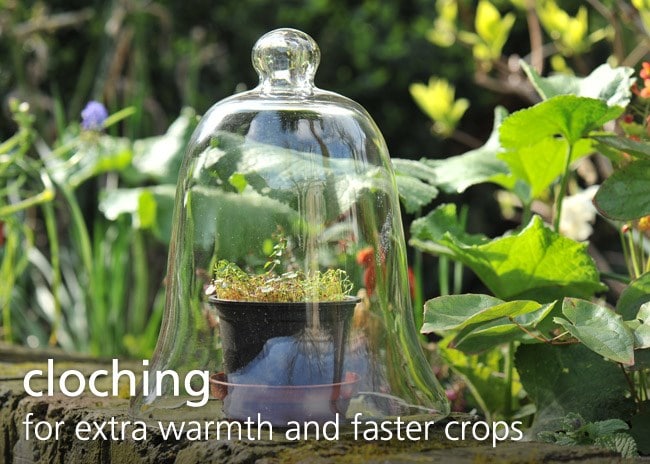Which Seeds to Buy ?
 Use early carrot varieties for speedy crops because they mature much faster. The blunt-ended, almost coreless carrot 'Early Nantes' is an excellent variety, however, if you Use early carrot varieties for speedy crops because they mature much faster. The blunt-ended, almost coreless carrot 'Early Nantes' is an excellent variety, however, if you
only have room for one, go for 'Amsterdam Forcing' because this variety matures about ten days
earlier. It also responds well to cloching, because its finger-sized carrots are sweet with a good orange colour.
 Carrots normally take between 10 and 20 days to emerge through the soil, however parsnips are much slower, taking 30 days at least. They can also be reluctant to germinate so it's far better to opt for a modern F1 parsnip like 'Gladiator' than a traditional one, as the hybrid vigour of 'Gladiator' gives you a much better germination rate. Parsnips have large papery seeds which blow away easily, so never sow them on windy days and if the soil is dry, water the drill well as this will keep the flyaway seeds in place. Whenever seeds are sown, cover the area with chicken wire and sticks to prevent cats and birds from unearthing them. Carrots normally take between 10 and 20 days to emerge through the soil, however parsnips are much slower, taking 30 days at least. They can also be reluctant to germinate so it's far better to opt for a modern F1 parsnip like 'Gladiator' than a traditional one, as the hybrid vigour of 'Gladiator' gives you a much better germination rate. Parsnips have large papery seeds which blow away easily, so never sow them on windy days and if the soil is dry, water the drill well as this will keep the flyaway seeds in place. Whenever seeds are sown, cover the area with chicken wire and sticks to prevent cats and birds from unearthing them.

Parsley is another member of the umbellifera family (just like carrot and parsnip) that can be sown now in pre-warmed ground. 'Extra Triple Curled' is a good performer and a short row at the end of your carrots is ideal. The seeds of these umbellifers do lose viability far quicker than most though, so check the dates on the packets and ditch any that are old. I allow my parsley to flower and produce heads of mustard-yellow flowers.  These mix well with easy annual flowers like Calendulas, orange Eschscholzia (Californian poppy) and Papaver (poppies). Sprinkle seeds of the handsome maroon-eyed orange Calendula 'Indian Prince', the frilly Eschscholzia 'Mission Bells' with any poppy seed to create waves of colour. These simple annuals are highly attractive to all pollinators, which will then go on to fertilise your beans and fruit. These mix well with easy annual flowers like Calendulas, orange Eschscholzia (Californian poppy) and Papaver (poppies). Sprinkle seeds of the handsome maroon-eyed orange Calendula 'Indian Prince', the frilly Eschscholzia 'Mission Bells' with any poppy seed to create waves of colour. These simple annuals are highly attractive to all pollinators, which will then go on to fertilise your beans and fruit.
Spinach 'Bloomsdale' can also be sown now. It produces dark-green rounded leaves and these rounder-leafed varieties tend not to bolt (ie. run to seed early) as often as those with triangular leaves. Sow every four weeks from March to July for a continuous crop from May to September. Beetroot 'Boltardy' is an excellent variety for early sowing as it tolerates extremes of weather without bolting. Both have large nobbly seeds that need sowing thinly, because each seed can produce several plants.
To Thin or Not To Thin?
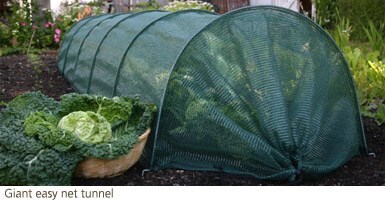
When sowing seeds, using a wider drill for your carrots, parsnips, spinach and beetroot allows your seedlings to spread, negating the need to thin them out. Thinning can sometimes attract pests so it is best avoided. When young carrots reach finger thickness (perfect for early crops), lift them to create more space for the rest. Cover the remaining roots up well straight afterwards. This will help avoid root disturbance and hopefully deter carrot root fly from laying their eggs. The larvae feed on the carrots and leave unsightly brown rings on the roots. The carrot fights back by producing a chemical to put the larvae off and this makes the carrot unpleasant to eat (for them as well as us). If root fly is a problem in your patch, make sure you rotate your carrots every year and remove all of them by the end of September. This will allow six months respite before more are sown. The ultimate deterrent however is the 3m long 'Giant Easy Net Tunnel', which could also be used to prevent cabbage white caterpillars getting on your brassica crops.
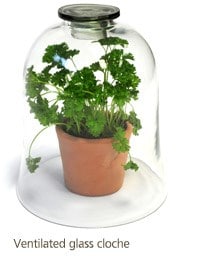 Which Cloche for Your Row of Seeds? Which Cloche for Your Row of Seeds?
Buying cloches should be considered as a garden investment for the future, so it's important to buy the right one for you. Ventilation is the key to success when covering plants because still, damp air will encourage fungal diseases like damping off and botrytis. So make time to either uncover your seedlings or young plants every day, exposing them to fresh air, or buy a cloche with a built-in ventilator like the 'Ventilated Glass Cloche'. Water regularly because rain will not penetrate most cloches and this includes enviromesh and horticultural fleece.
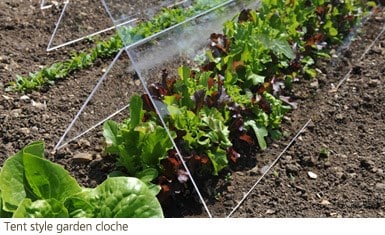
Clear glass was traditionally used for rows of seedlings, but it's easy to break and highly dangerous for children and pets. The 'Tent Style Garden Cloche' is made from much safer 3mm thick acrylic and looks just like glass, but it's stronger. It's perfect for protecting your plants from strong winds and UV sun damage. The 'Tent' comes in two lengths, the shorter one measures 50cm and the longer is a full metre in length. Both are heavy enough to stay in place, should your garden be exposed and windy.
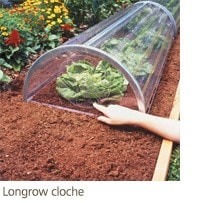 The 'Longrow Cloche' measures 1.2m and its generous proportions allow you to use this with dwarf beans, strawberries, melons, salad and all root crops. The circular end panels turn at a touch for adjustable ventilation and it has a rugged steel frame, so it too will stay put even in windy gardens. The corrugated PVC is tough enough to cope with all sorts of weather and it can be stored from year to year. The 'Longrow Cloche' measures 1.2m and its generous proportions allow you to use this with dwarf beans, strawberries, melons, salad and all root crops. The circular end panels turn at a touch for adjustable ventilation and it has a rugged steel frame, so it too will stay put even in windy gardens. The corrugated PVC is tough enough to cope with all sorts of weather and it can be stored from year to year.
 The 1m long 'Kitchen Garden Cloche' is more stylish, yet very sturdy. The high quality U.V. resistant clear plastic is held in galvanised black powder coated steel. It has adjustable air vents and galvanised steel ground pegs for securing to the ground, plus a handy handle. Plastic cloches are usually much lighter and they do need pegging down to prevent them blowing away in rough weather. The 1m long 'Kitchen Garden Cloche' is more stylish, yet very sturdy. The high quality U.V. resistant clear plastic is held in galvanised black powder coated steel. It has adjustable air vents and galvanised steel ground pegs for securing to the ground, plus a handy handle. Plastic cloches are usually much lighter and they do need pegging down to prevent them blowing away in rough weather.
Highly Decorative and Practical
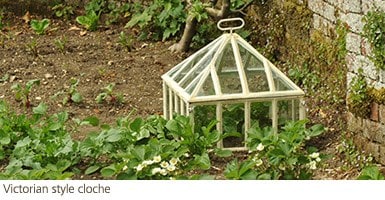
Cloching is an ancient art and the Romans were known to protect their cucumbers with glass covers. However it was the French who perfected the art of raising crops under glass. They used giant glass bell jars, which they called cloches. These were originally blown by Italian glassmakers in the late 16th century and reached the south of France a little later. Olivier de Serres (literally Oliver of the Greenhouses) used them to raise melons by 1600. The big glass hats became known as cloches in France, but they were expensive to produce and highly breakable. By 1677 square cloches with pieces of glass set in lead were being made in England. Often old window panes were used in their construction and, if a piece of glass broke it could be replaced. Both were highly decorative. They were propped up on wood during the day, or moved to one side and then replaced for the night. That method helped to harden off the crop.
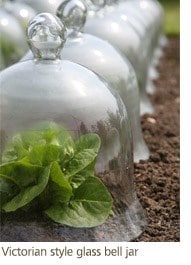 Modern reproductions add great style to productive kitchen gardens, potagers and wildflower areas, as well as giving protection to tender crops and plants. The rugged, square 'Victorian Style Cloche' can be left out all year and their cream paintwork and slightly rusty patina mixes well with vegetables and annuals, making a real feature to focus the eye. There are also rounder 'Bell Cloches' in heavy glass, the larger ones being the most useful and decorative outside, whilst the smaller ones are also useful indoors and out. Modern reproductions add great style to productive kitchen gardens, potagers and wildflower areas, as well as giving protection to tender crops and plants. The rugged, square 'Victorian Style Cloche' can be left out all year and their cream paintwork and slightly rusty patina mixes well with vegetables and annuals, making a real feature to focus the eye. There are also rounder 'Bell Cloches' in heavy glass, the larger ones being the most useful and decorative outside, whilst the smaller ones are also useful indoors and out.
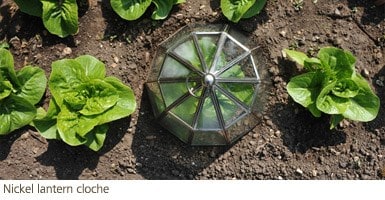
Crocus have also designed their own 'Lantern' range of reproduction cloches in nickel and bronzed metal, both in two sizes. These handsome cloches could be used with ferns as well as productive crops.
Which Crops and Plants Need Cloching ?
Frost tender plants can be encouraged to grow far more quickly under cloches and one group of plants, the cucurbits, benefit from the extra warmth overnight. This allows them to photosynthesise for longer and squash, courgette and outdoor cucumber plants that are grown under a cloche will usually double in size within four weeks. Early strawberries also need protecting from spring frosts, so they too will benefit from being tucked up under a cloche. Tender ornamentals, including Salvias and Melianthus major (to name just a few) can also benefit.
Simple but Stylish Protection
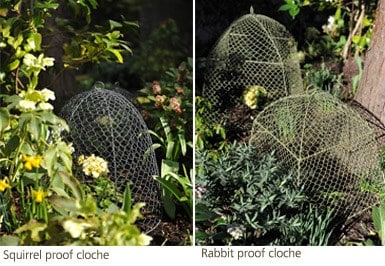
If rabbits, deer, squirrels or cats devour or scratch up your plants these wire mesh protectors will give them time to get established. The pyramid-shaped 'Rabbit Proof Cloche' and dome-shaped 'Squirrel Proof Cloche' are also perfect for protecting newly planted bulbs. They are handsome enough to crown a pot, if needed.
|
Preparing the Ground for Cloching

Prepare the ground well so that the soil is fine and then water it well if it's dry.
Cover with your cloche making sure the ends are blocked off too.
Open the ends regularly to allow the air to circulate.
After two weeks sow the seeds, water again if necessary, and cover once again with the cloche.
If cold weather is forecast fleece over your plastic or glass cloche with double layers of horticultural fleece.
What to Sow Now
Sow seeds of the outdoor cucumber 'Marketmore', courgette 'Romanesco' and courgette 'Defender' now, straight into 3 inch round pots. The large seeds of these curcubits should be sown vertically rather than laid flat, allowing one per pot. 'Butternut' squashes will also do well in warmer parts of the country. Pot on your plants under glass, if possible, and don't place them outside until June.
Five Jobs for April
|



